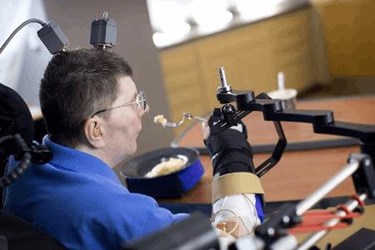Brain Implant Restores Movement To Limbs Paralyzed For Eight Years

A man from Cleveland, Ohio became the first in the world to have movement restored in his previously paralyzed arm and hand with the help of a temporary brain implant, said scientists from Case Western Reserve University (CWR). The BrainGate system, which uses a brain-computer interface (BCI) and a functional electrical stimulation (FES) system to reconnect the brain to muscles, is being called a “major step” toward restoring the independence of people with spinal cord injuries.
The BrainGate system was originally designed and owned by Brown University spinoff Cyberkinetics, which withdrew from the research in 2008 to focus solely on biosensors and data acquisition software. Currently, BrainGate is a privately owned research consortium of scientists from several partnering academic institutions and hospitals, including Brown, Stanford, CWR, Providence VA Medical Center, and the Massachusetts General Hospital.
The first clinical trial with the BrainGate system ran from 2004 to 2006, studying patients with tetraplegia, who were able to use the BCI to control a cursor on a screen just by thinking about where they wanted it to go. Recent trials have demonstrated the system’s ability to restore communication by people with paralysis using an intracortical BCI, and have further refined the system’s ability to restore movement.
Bill Kochevar, a 56-year-old man from Cleveland who was paralyzed from the shoulders down by a bicycling accident eight years ago, was implanted with the BrainGate system in 2014 as part of clinical research led by Bob Kirsch, chair of CWR’s department of biomedical engineering. Both the Louis Stokes Cleveland VA Medical Center and University Hospitals Cleveland participated in the study, which was published in The Lancet.
In the proof-of-concept study, researchers implanted two intracortical microelectrode arrays in Kochevar’s motor cortex, and placed another 36 implants in his right arm. Working together, the implants are able to bypass his injury and translate brain signals into hand and arm movements.
Kirsch told NPR that a specially designed algorithm “transforms” neural signals into Kochevar’s intended movements. “I think what we’ve done is show that we can pull this all together and it’s feasible. We can actually record signals from his brain and determine what he’s trying to do and make it happen.”
With the implants, Kochevar is able to execute both single joint and multi-joint arm movements with 80 to 100 percent accuracy. Two years after the initial implant, Kochevar is able to drink a mug of coffee and feed himself. Researchers noted that this breakthrough is the first report of a combined FES and iBCI prosthesis restoring reaching and grasping movements in a patient with permanent spinal cord injury.
“He’s really breaking ground for the spinal cord injury community,” said Kirsch. “This is a major step toward restoring some independence.”
Related, tech billionaire Elon Musk recently announced his involvement in a biomedical startup, Neurolink, which will pursue advanced brain-machine interfaces that could one day merge the human mind with AI technology, and provide much-needed treatments for neurological disorders.
